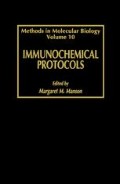Abstract
The classical technique for IDentifying cells engaged in dNA synthesis is by their uptake of [3H]-thymIDine, detected using autoradiography. However, this method can be inconvenient, as specialized darkroom and radioisotope facilities are required, with the potential health hazard that handling isotopes entails. BromodeoxyurIDine (BrdU), the halogenated 5-substituted derivative of deoxyurIDine, is a thymIDine analog specifically incorporated into the dNA of proliferating cells during S phase. This is now a well-established alternative to 3H thymIDine, since it has been shown that labeling indices for the two molecules are the same (1, 2). The development of a monoclonal antibody (3) that recognizes BrdU incorporated into single-stranded dNA has resulted in several techniques using immunocytochemical staining to detect incorporated BrdU in frozen, paraffin- and plastic-embedded sections of tissue by light microscopy. It has also proved extremely valuable for studies in conjunction with flow cytometry and even, for in vivo studies of human tumor cell kinetics (see this vol., Chapter 43). We describe here a method to detect dNA synthesis by in vivo labeling of nuclei with BrdU, followed by indirect immunological detection in paraffin-embedded tissue (4).
Access this chapter
Tax calculation will be finalised at checkout
Purchases are for personal use only
References
Schutte, B., Reynders, M.M.J., Bosman, F.T., and Blijham, G.H. (1987) Studies with antibromodeoxyurIDine antibodies: II Simultaneous immunocytochemical detection of antigen expression and dNA synthesis by in vivo labelling of intestinal mucosa. J. Histochem. Cytochem. 35, 371–374.
Lanier, T. L., Berger, E. K., and Eacho, P. I. (1989) Comparison of 5-bromo-2-deoxyurIDine and [3H]thymIDine for studies of hepatocellular proliferation in rodents. Carcinogenesis 10, 1341–1343.
Gratzner, H. G. (1982) Monoclonal antibody to 5-bromo and 5-iododeoxyurIDine: A new reagent for detection of dNA replication. Science 218, 474,475.
Wynford-Thomas, D. and Williams, E. D. (1986) Use of bromodeoxyurIDine for cell kinetic studies in intact animals. Cell Tissue Kinetics 19, 179–182.
Author information
Authors and Affiliations
Editor information
Editors and Affiliations
Rights and permissions
Copyright information
© 1992 The Humana Press, Inc., Totowa, NJ
About this protocol
Cite this protocol
Green, J.A., Edwards, R.E., Manson, M.M. (1992). Immunohistochemical detection of BromodeoxyurIDine-Labeled Nuclei for In Vivo Cell Kinetic Studies. In: Manson, M.M. (eds) Immunochemical Protocols. Methods in Molecular Biology, vol 10. Humana Press, Totowa, NJ. https://doi.org/10.1385/0-89603-204-3:131
Download citation
DOI: https://doi.org/10.1385/0-89603-204-3:131
Publisher Name: Humana Press, Totowa, NJ
Print ISBN: 978-0-89603-204-0
Online ISBN: 978-1-59259-497-9
eBook Packages: Springer Protocols

